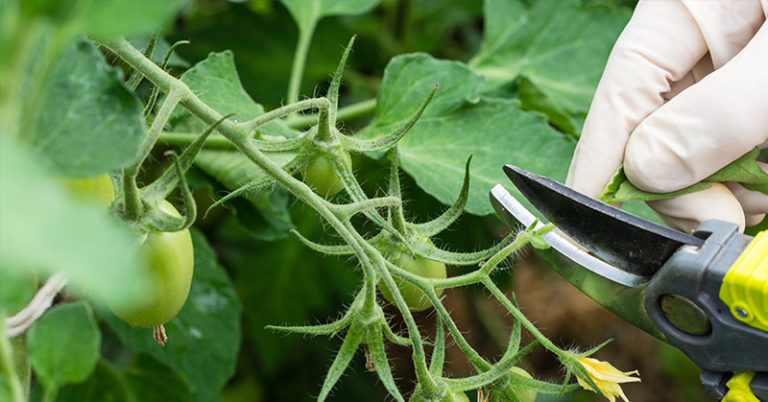The first time I tried a home-grown tomato I thought to myself, “So this is what tomatoes are supposed to taste like!” Nothing beats a fresh tomato, home-grown, just picked from the vine. The juices exploded in my mouth with the taste of summer and joy. As the summer heat sets in, many people are heading out to their own home gardens to tend to the tomato plants. You may be de-bugging them and watering them, but are you pruning them? Let’s talk about how to prune tomatoes
Pruning tomato plants can improve your crops, and even extend the harvest season. While you’re at it, use poles, trellises, or cages to keep the tomato vines off of the ground. This will prevent fungal diseases and improve the overall quality of the fruit. If the leaves are covered, they won’t get any sunlight and will struggle to survive. This leads to a smaller and less productive harvest. So learning how to prune tomatoes is vital to a better harvest.
There are two main types of tomatoes, determinate or indeterminate growth habits. When and how you should prune your plants depends on their growth habits. Determinate tomatoes tend to grow in a bush-like growth habit. They cease growing around 4 feet, which is when then set a terminal bud. Their season is short and defined but they tend to produce earlier than indeterminate types. Indeterminate types don’t stop growing, setting new flowers, and producing fruit until cold weather stops them.
Here are examples of each variety:
Determinate:
- Beefsteak type: Mountain Fresh, Rutgers, Florida 47, Celebrity, Orange Blossom
- Plum type: Plum Dandy, Roma, San Marzano
Indeterminate:
- Cherry type: Sweet 100, Sungold, Matt’s Wild Cherry
- Grape type: Juliet, Red Grape
- Beefsteak: Big Beef, Big Boy, Early Girl, Jet Star
- Heirloom/Specialty: Brandywine, Green Zeebra, Cherokee Purple, Black Krim
Read More: Farmer finds new technique for preserving tomatoes
How to prune tomatoes
The Basket Weave
The basket weave can be used for outdoor gardens or in greenhouses, as well as for determinate or indeterminate varieties. It is best suited to determinate type but it works well with indeterminate types if they are trimmed when they reach the top of the stakes. Instead of staking each vine, this system cuts the effort and the number of stakes needed in half.
Here’s how it works:
- Choose 4-5 ft sturdy wooden stakes (5 ft stakes for indeterminate types) with two stakes for each end of the row to double their strength.
- Set each stake about six inches into the earth, one stake per every 2–3 plants. Place the stakes there when the seedlings are transplanted.
- Ensure the seedlings are supported as soon as they have set their first cluster of flowers.
- To support the vines, tie a sturdy twine from the double stakes at the end of the row, about 12 inches off the ground. Weave the twine in a figure eight pattern between the plants before securing it to the opposite stake. Now do the same on the opposite end until the plants have twine on either side of them, holding them up.
- As the plants grow, add another weave of twine about 6–8 inches higher. You will probably need a maximum of four layers.
- Remove the new shoots that come out of the leaf axis (also called ‘suckers’). This may lower the harvest but it increases airflow in the plant. Allow the suckers around the first flower cluster to grow, however.
- When indeterminate varieties exceed the stakes, cut off the tops to prevent it from becoming too heavy. It will look like a little hedge.
Keep Reading: Your Guide To Container Gardening Tomatoes
The Overhead Trellis
The overhead trellis is best for tomatoes grown indoors where overhead support is already there, and for indeterminate types. This system is more labor-intensive that the basket weave, but it is longer-lasting.
- Ensure there is a strong support at least 8 ft over each row of tomatoes, like a metal conduit or a heavy-gauge wire. Remember, each plant can weigh up to 30 pounds, so whatever support you choose, make sure it could hold this amount of weight.
- Cut a piece of twine that’s long enough to reach the overhead support and the earth. If you’re planning to grow the tomato plants long-term, use specialized hooks and rollers so you can lengthen the twine as the plants become taller.
- Once the plants have their first flower clusters, or when they are at least 12 inches tall, start supporting the tomatoes on the twine. Use a tomato clip to attach them at the base of the plant.
- You can train trellised tomatoes to one or two leaders. If you are keeping one, remove all of the suckers (this is recommended.) If you are keeping two, keep the sucker just below the first cluster of flowers and remove all the others. Be sure to cut off the suckers while they are less then 2 inches small.
- As the plant grows, keep attaching it to the twine with clips, about every 12–18 inches. Reposition the tomatoes as needed. Attach the clips beneath the leaves, not beneath the cluster of fruit to avoid damaging the tomatoes. Alternatively, you can wrap the plant around the twine instead of using clips.
- Remove lower leaves to maintain a good airflow, but don’t touch the leaves underneath the lowest cluster of tomatoes and any leaves higher than that.
- When the plant grows up to the support, you can trim the top or lower the vine if you’d like it to continue growing by releasing more twine. This lets the plant gently lean without snapping.
We hope this guide on how to prune tomatoes is helpful! Happy gardening.
Keep Reading: How To Save Tomato Seeds To Grow Next Spring













